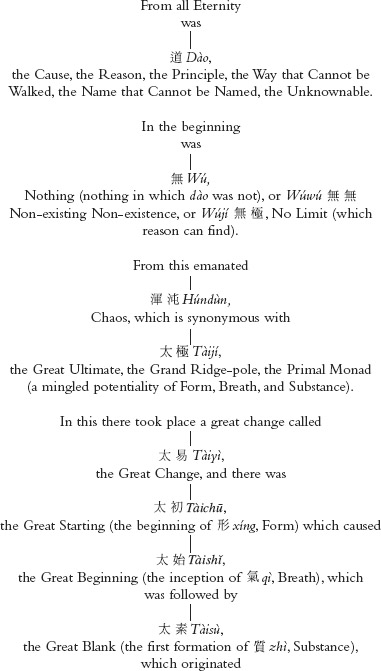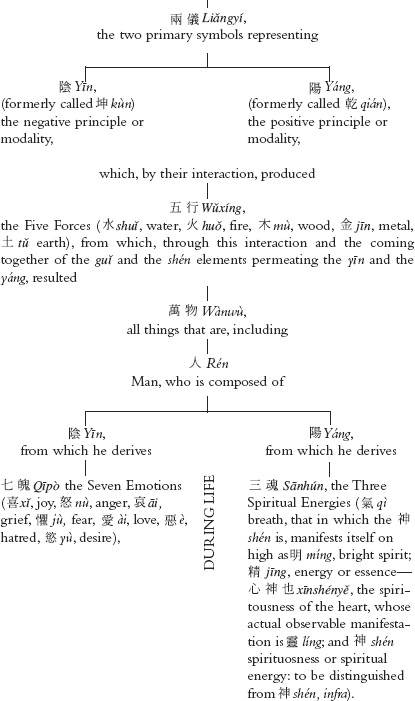Yama
(閣羅)
Sanskrit Yama, a twin. The judge and ruler of the departed; the Hindu Pluto, or king of the infernal regions; originally conceived of as one of the first pair from whom the human race is descended, and the beneficent sovereign of his descendants in the abodes of the blest; later a terrible deity, the tormentor of the wicked. He is represented of “a green colour with red garments, having a crown on his head, his eye inflamed, and sitting on a buffalo, with a club in one hand.”293
“Yama was originally the Aryan god of the dead, living in a heaven above the world, the regent of the south; but Brahmanism transferred his abode to hell. Both views have been retained by Buddhism.”294 “He has a sister who controls all the female culprits, as he exclusively deals with the male sex. Three times, however, in every twenty-four hours, a demon pours boiling copper into his mouth, and squeezes it down his throat, causing him unspeakable pain. Such, however, is the wonderful ‘transrotation of births,’ that when his sins have been expiated, he is to be reborn as a Buddha, under the name of ‘The Universal King.’”295
The Buddhist-Taoist purgatory consists of Ten Courts of Justice situated in different positions at the bottom of a vast ocean, which lies down in the depths of the earth. These are subdivided into special wards, different forms of torture being inflicted in each. Taoist temples often contain graphic representations of the torments of the nether world, of which a full description is given in the Taoist work “Yù Lì Chāo Zhuàn ” (玉  鈔 傳), which dates from the the Sòng Dynasty.
鈔 傳), which dates from the the Sòng Dynasty.
“The journey of the departed spirit to Hades is described with a wealth of illustration and elaboration, and is divided into seven periods of seven days, or ‘weeks,’ which correspond with the various stages of the spirit’s wanderings in the infernal regions. The first ‘week,’ when the traveller reaches the ‘Demon Gate Barrier’ (鬼門關) and is assailed by demons who demand his money, on the excuse that at his last transmigration he borrowed so much from the infernal treasury and must now return it. If he has money to pay he is let pass, but if not he is beaten, stripped, and suffers many indignities. The second ‘week’ he comes to a place where he is weighed: the good man proves to be as light as air, but the evil are borne down by their ill deeds and are punished by being sawn asunder, ground to powder, etc. Nirvana, however, is still very far off, a wave of the ‘two-sided fan’ restores him to his former condition and he is sent forward on his journey. The third ‘week’ he arrives at the ‘Bad Dog Village’ (惡 狗 村), where, if good, he is recognised joyfully by the fierce beasts, but, if evil he is torn until his blood flows in rivers. At the fourth ‘week,’ a gigantic mirror, called the ‘Mirror of Retribution’ (業 鏡), is exhibited: the good man on looking into it sees himself as he is, in all the beauty of innocence, but the sinner sees only the presentiment of the doom which awaits him; is he to be turned into an animal? then an animal form is reflected before his horrified vision. The fifth ‘week’ he begs to be allowed to return to life, but the God replies that he is no longer fit to take his place with uncorrupted mortals; he thereupon begs at least to be permitted to take a last look at his old home, and is allowed to ascend a high platform from whence he may obtain a view. He sees his loved ones at home, occupied with their various duties, and his heart is all the more sorrowful as he realises that he himself has no longer a place in mundane affairs. In the sixth ‘week’ he reaches the bridge which spans the ‘Inevitable River’ (奈何 橋). This bridge is very high and showing enormous snakes lifting their heads high out of the water on the look-out for human flesh. At the foot of the bridge stand lictors who, with iron maces and other weapons, force the unwilling travellers to ascend the bridge and essay the crossing which inevitably ends in destruction. The bridge is 100,000 feet high and 1 inch and 3/10ths wide, and the only possible way of crossing is by ‘riding’ straddle-legged as on a horse. The good are not forced to attempt the passage, but are led by the ‘Golden Youth’ and his companion on to the ‘Fairy Bridges,’ the gold and silver bridges which cross the river at the side of this demon ‘Bridge of Sighs.’ In the seventh ‘week’ the abode of the ‘Rajah of the Wheel’ is reached (轉輪王), and he is petitioned by the traveller to expedite the process of transmigration. The petitioner is handed over to a ‘Runner,’ who takes him off to the place of the wheel; and on the way to a rest-house is visited, where old Mrs. Mèng (孟 婆) gives tea ‘free gratis’ to passers-by, they being already thirsty after all their experiences. When the good man has imbibed the tea he enjoys a comfortable sensation, and a sense of coolness takes possession of him, but the moment the evil-doer tastes the liquid, he forgets all the past, both good and bad. The victim is then driven on towards the great ‘Wheel of the Law’ (法 輪) and takes his place between the revolving spokes. If he is permitted to escape at the top right-hand corner he finds himself, on re-incarnation, admitted into the ranks of the nobility; if by the top left-hand corner he is relegated to the status of widower or widow, orphan or childless, the lame, the halt, and the blind; if he emerges on the right-hand, lower down, he is classed among viviparous animals; if on the left-hand, among oviparous animals. The right-hand, still lower, is the place of creatures with shells or scales; the left-hand corresponding is the sphere of insects.”296

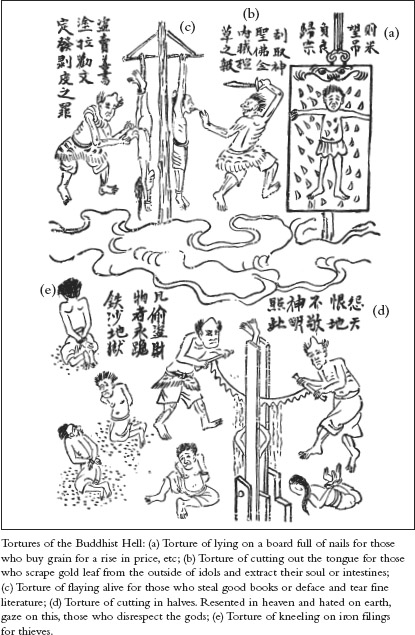
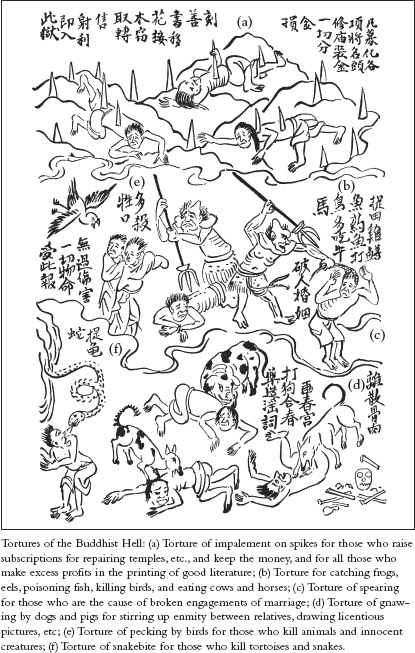
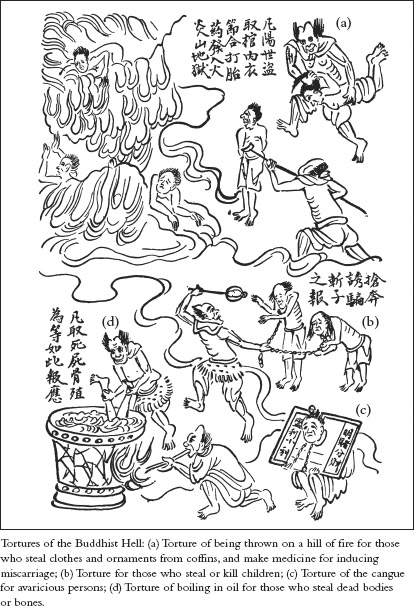
“The Pratas (of the Hindoo mythology)—in Chinese guî (鬼), ‘demons’—are the inhabitants of the narakas or ‘subterranean’ and other ‘prisons’ called dìyù (地 獄), ‘hell’. Many of them formerly belonged to the world of men. Some are condemned by Yama (the Prince of Hell) to certain prisons. Others haunt the graves where their former bodies are interred. The Pratas hunger for food, and hence the custom is prevalent in China of feeding the hungry ghosts both of relatives and of others.”297 (Vide also ANCESTRAL WORSHIP, MANJUSRI, DI ZANG, WHEEL OF THE LAW.)
Yáo
(堯)
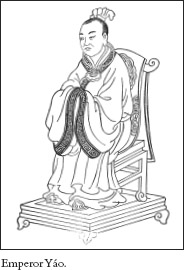
The famous legendary Emperor of China’s Golden Age. He is said to have been born with eyebrows of eight different colours. He came to the throne in 2357 B.C., and, after a glorious reign of 70 years or more, he abdicated in favour of Shùn (q. v.).
Yïn and Yáng
(陰陽)
Chinese cosmogony is based upon the principle of dualism, which has its parallel in the Ormuz and Ahriman of the Persians, the masculo-feminine principle of the ancient Egyptians, the subdivision of the Hondoo God Brahma into male and female elements for the creation of the world, and Plato’s theory of universal dualism, etc.
The y ï n (陰) and yáng (陽) are the negative and positive principles of universal life, and are pictorially represented by the symbol  , which is the diagram of an egg showing the yolk and the white strongly differentiated, the dark and light colours distinguishing the two principles. Yáng signifies Heaven, Sun, Light, Vigour, Male, Penetration, the Monad. “It is symbolized by the Dragon and is associated with azure colour and oddness in numbers. In fēngshuî, or the geomantic system of orientation, raised land forms (mountains) are yáng. Similarly y ï n stands for Earth (the antithesis of Heaven), Moon, Darkness, Quiescence, Female, Absorption, the Duad. It is symbolized by the Tiger and is associated with orange colour and even numbers. Valleys and streams possess the y ï n quality.”298
, which is the diagram of an egg showing the yolk and the white strongly differentiated, the dark and light colours distinguishing the two principles. Yáng signifies Heaven, Sun, Light, Vigour, Male, Penetration, the Monad. “It is symbolized by the Dragon and is associated with azure colour and oddness in numbers. In fēngshuî, or the geomantic system of orientation, raised land forms (mountains) are yáng. Similarly y ï n stands for Earth (the antithesis of Heaven), Moon, Darkness, Quiescence, Female, Absorption, the Duad. It is symbolized by the Tiger and is associated with orange colour and even numbers. Valleys and streams possess the y ï n quality.”298
The celestial principle (or soul of the universe), tiānlî (天理) first existed, combined with the immaterial principle qì (剩), or vapour, and then came primary matter (器), which accumulated and constituted substance (or the qualities of matter) zhì (質), from which all creation evolved. The Great Monad or Extreme—the first cause—TAIJI (太極) (q. v.) being contained in the immaterial principle, moved and produced the yáng, the superior or male principle of native. When it had moved to the utmost it rested; and having rested, it produced the y ï n, the inferior or female principle of nature. When the pure male principle was diluted, it formed the heavens; while the dark and heavy y ï n coagulated and formed the earth. The y ï n and the yáng together constitute the dào (道), the eternal reason or principle of heaven and earth, the origin of all things human and divine, and thence was finally produced the jì 繼 or Succession.
The following diagram of the Chinese cosmology illustrates the process of change and evolution out of the Unknown and the ultimate return into it, and is quoted from a paper on “The Chinese Idea of the Second Self,” read at a meeting of the Things Chinese Society, on the 26th May, 1931, at Peiping, China, by Mr. E. T. C. Werner.
